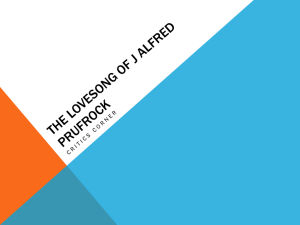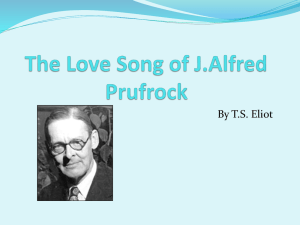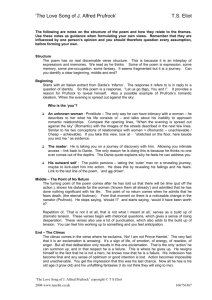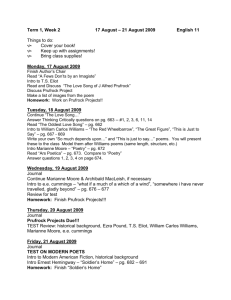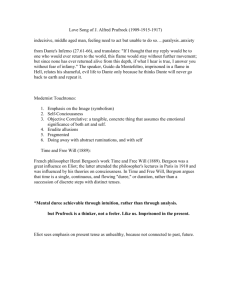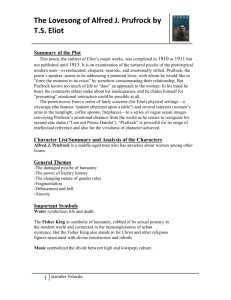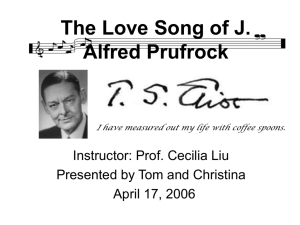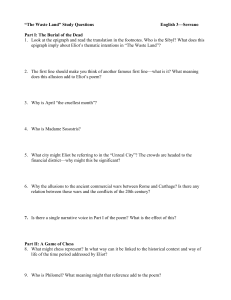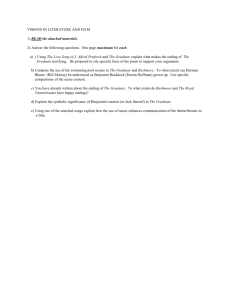English Intertext Essay
advertisement
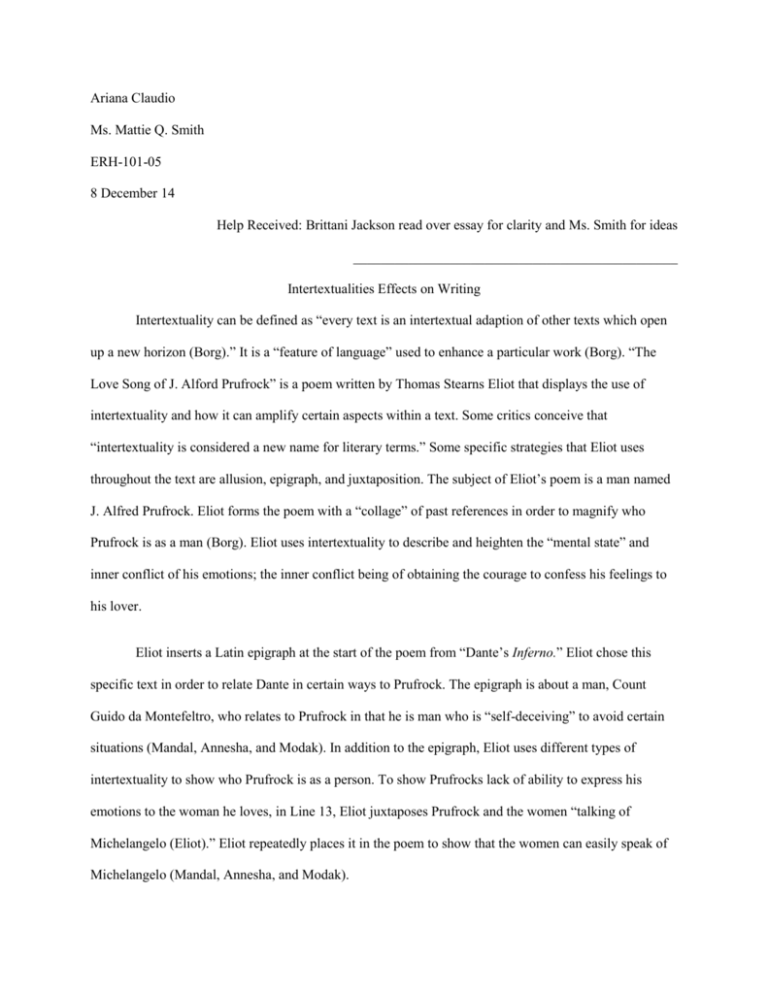
Ariana Claudio Ms. Mattie Q. Smith ERH-101-05 8 December 14 Help Received: Brittani Jackson read over essay for clarity and Ms. Smith for ideas _______________________________________________ Intertextualities Effects on Writing Intertextuality can be defined as “every text is an intertextual adaption of other texts which open up a new horizon (Borg).” It is a “feature of language” used to enhance a particular work (Borg). “The Love Song of J. Alford Prufrock” is a poem written by Thomas Stearns Eliot that displays the use of intertextuality and how it can amplify certain aspects within a text. Some critics conceive that “intertextuality is considered a new name for literary terms.” Some specific strategies that Eliot uses throughout the text are allusion, epigraph, and juxtaposition. The subject of Eliot’s poem is a man named J. Alfred Prufrock. Eliot forms the poem with a “collage” of past references in order to magnify who Prufrock is as a man (Borg). Eliot uses intertextuality to describe and heighten the “mental state” and inner conflict of his emotions; the inner conflict being of obtaining the courage to confess his feelings to his lover. Eliot inserts a Latin epigraph at the start of the poem from “Dante’s Inferno.” Eliot chose this specific text in order to relate Dante in certain ways to Prufrock. The epigraph is about a man, Count Guido da Montefeltro, who relates to Prufrock in that he is man who is “self-deceiving” to avoid certain situations (Mandal, Annesha, and Modak). In addition to the epigraph, Eliot uses different types of intertextuality to show who Prufrock is as a person. To show Prufrocks lack of ability to express his emotions to the woman he loves, in Line 13, Eliot juxtaposes Prufrock and the women “talking of Michelangelo (Eliot).” Eliot repeatedly places it in the poem to show that the women can easily speak of Michelangelo (Mandal, Annesha, and Modak). The element of Time is used many times in the poem to provide an explanation for why Prufrock continuously stops himself from addressing his lover. Eliot uses an allusion to contrast how Prufrock is using time (Mandal, Annesha, and Modak). The subject in Andrew Marvell’s poem, “To His Coy Mistress,” uses time to convince his lover that there is not enough time; therefore the subject’s lover should make love to him. Prufrock’s self-consciousness is clear in that he feels people will point out his growing in age. He has an internal battle with himself thinking that some will notice the “bald spot in the middle of my hair” or “how his arms and legs are thin (Eliot).” Eliot uses the reference from Shakespeare’s “Hamlet” when Polonius states “for you yourself, sit, should be old as I am, if like a crab you could go backwards (Mandal, Annesha, and Modak).” Prufrock is aware of his own lack of valor and compares himself to the image of a crab (Mandal, Annesha, and Modak). Eliot shows the distinction of how Prufrock feels about himself to the story of John the Baptist. Prufrock says that “Though I have seen my head (grown slightly bald) brought in upon a platter (Eliot).” John the Baptist was beheaded and brought in on a platter (Mandal, Annesha, and Modak). He was beheaded was because he said that the marriage of Herod and Herodias was unlawful (Mandal, Annesha, and Modak). Eliot is contrasting Prufrock’s lack of courage to speak the truth with John the Baptist’s daring statement. Prufrock states that he is aware of his weakness in that he states “I am no prophet (Eliot).” Prufrock again shows his awareness of his weaknesses when Eliot uses the reference of Hamlet and the “attendant lord (Eliot).” Hamlet, in Shakespeare’s Hamlet, possesses the same characteristic of Prufrock of indecisiveness as does Prufrock but the difference between the two is that Hamlet is “majestic and charismatic (Cummings).” Prufrock says that “No! I am not Prince Hamlet…Am an attendant lord (Eliot).” Here Prufrock is saying that he does not have the good qualities that Hamlet has; instead he relates himself to the unimportant attendant lord (Cummings). Prufrock wants to approach his lover but instead he sits in the background; just like the character of the attendant lord. Prufrock is showing that he lacks the values of majesties and charisma that Hamlet thrives upon. The past references that Eliot uses are Dante Alighieri’s Inferno, Andrew Marvell’s poem “To His Coy Mistress,” Shakespeare’s Hamlet, and the story of John the Baptist. The most used strategy that Eliot uses within the poem is the element of compare and contrast. Comparing and contrasting Prufrock to the multiple subjects in the past references adds to the readers understanding of the inner turmoil of J. Alfred Prufrock struggles with. For example, Eliot opens the poem with the epigraph of Dante’s Inferno. The epigraph gives the reader an initial look at Prufrock’s lack of bravery when certain situations arise. Eliot shows within the constrast of Prufrock and the subject of “To His Coy Mistress” by accentuating their extreme differences. Prufrock is dependent on the need for endless time whereas the opposing character feels that there is never enough time. Eliot chose the references that he did in order to focus in on Prufrocks character. Each reference discusses a different aspect of Prufrocks personality and the conflict that he has yet to resolve. Word Count: 855 Works Cited Borg, Erik. "Local Plagiarisms." Assessment & Evaluation In Higher Education 34.4 (2009): 415-426. Academic Search Complete. Web. 4 Dec. 2014. Mandal, Annesha, and Modak. "The Love Song of J. Alfred Prufrock: A Postmodern Poem with a Postmodern Hero." (12, February 2013 ): n. page. Print. Eliot, Thomas. Bartleby.com. N.p.. Web. 6 Dec 2014. <http://www.bartleby.com/198/1.html>. Cummings, Michael J. The Love Song of J. Alfred Purfrock: Study Guide, <http://cummingsstudyguides.net/Guides3/Prufrock.html>
